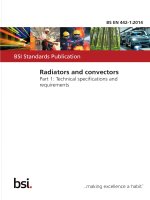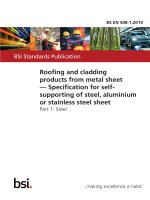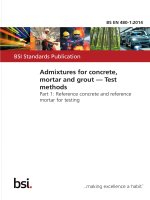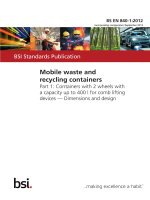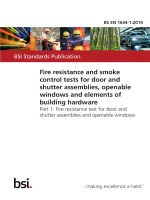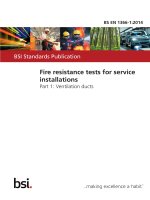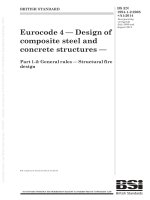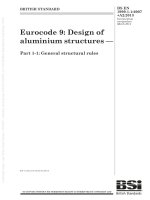Bsi bs en 61978 1 2014
Bạn đang xem bản rút gọn của tài liệu. Xem và tải ngay bản đầy đủ của tài liệu tại đây (1.41 MB, 34 trang )
BS EN 61978-1:2014
BSI Standards Publication
Fibre optic interconnecting
devices and passive
components — Fibre
optic passive chromatic
dispersion compensators
Part 1: Generic specification
BRITISH STANDARD
BS EN 61978-1:2014
National foreword
This British Standard is the UK implementation of EN 61978-1:2014. It
is identical to IEC 61978-1:2014. It supersedes BS EN 61978-1:2010
which is withdrawn.
The UK participation in its preparation was entrusted by Technical
Committee GEL/86, Fibre optics, to Subcommittee GEL/86/2, Fibre optic
interconnecting devices and passive components.
A list of organizations represented on this committee can be obtained on
request to its secretary.
This publication does not purport to include all the necessary provisions of
a contract. Users are responsible for its correct application.
© The British Standards Institution 2014.
Published by BSI Standards Limited 2014
ISBN 978 0 580 82164 6
ICS 33.180.01
Compliance with a British Standard cannot confer immunity from
legal obligations.
This British Standard was published under the authority of the
Standards Policy and Strategy Committee on 30 September 2014.
Amendments/corrigenda issued since publication
Date
Text affected
BS EN 61978-1:2014
EUROPEAN STANDARD
EN 61978-1
NORME EUROPÉENNE
EUROPÄISCHE NORM
August 2014
ICS 33.180.01
Supersedes EN 61978-1:2010
English Version
Fibre optic interconnecting devices and passive components Fibre optic passive chromatic dispersion compensators - Part 1:
Generic specification
(IEC 61978-1:2014)
Dispositifs d'interconnexion et composants passifs à fibres
optiques - Compensateurs de dispersion chromatique
passifs à fibres optiques - Partie 1: Spécification générique
(CEI 61978-1:2014)
Lichtwellenleiter - Verbindungselemente und passive
Bauteile - Passive Lichtwellenleiter - Kompensatoren mit
chromatischer Dispersion - Teil 1: Fachgrundspezifikation
(IEC 61978-1:2014)
This European Standard was approved by CENELEC on 2014-06-27. CENELEC members are bound to comply with the CEN/CENELEC
Internal Regulations which stipulate the conditions for giving this European Standard the status of a national standard without any alteration.
Up-to-date lists and bibliographical references concerning such national standards may be obtained on application to the CEN-CENELEC
Management Centre or to any CENELEC member.
This European Standard exists in three official versions (English, French, German). A version in any other language made by translation
under the responsibility of a CENELEC member into its own language and notified to the CEN-CENELEC Management Centre has the
same status as the official versions.
CENELEC members are the national electrotechnical committees of Austria, Belgium, Bulgaria, Croatia, Cyprus, the Czech Republic,
Denmark, Estonia, Finland, Former Yugoslav Republic of Macedonia, France, Germany, Greece, Hungary, Iceland, Ireland, Italy, Latvia,
Lithuania, Luxembourg, Malta, the Netherlands, Norway, Poland, Portugal, Romania, Slovakia, Slovenia, Spain, Sweden, Switzerland,
Turkey and the United Kingdom.
European Committee for Electrotechnical Standardization
Comité Européen de Normalisation Electrotechnique
Europäisches Komitee für Elektrotechnische Normung
CEN-CENELEC Management Centre: Avenue Marnix 17, B-1000 Brussels
© 2014 CENELEC All rights of exploitation in any form and by any means reserved worldwide for CENELEC Members.
Ref. No. EN 61978-1:2014 E
BS EN 61978-1:2014
EN 61978-1:2014
-2-
Foreword
The text of document 86B/3639/CDV, future edition 3 of IEC 61978-1, prepared by SC 86B "Fibre
optic interconnecting devices and passive components" of IEC/TC 86 "Fibre optics" was submitted to
the IEC-CENELEC parallel vote and approved by CENELEC as EN 61978-1:2014.
The following dates are fixed:
•
latest date by which the document has to be
implemented at national level by
publication of an identical national
standard or by endorsement
(dop)
2015-03-27
•
latest date by which the national
standards conflicting with the
document have to be withdrawn
(dow)
2017-06-27
This document supersedes EN 61978-1:2010.
Attention is drawn to the possibility that some of the elements of this document may be the subject of
patent rights. CENELEC [and/or CEN] shall not be held responsible for identifying any or all such
patent rights.
Endorsement notice
The text of the International Standard IEC 61978-1:2014 was approved by CENELEC as a European
Standard without any modification.
In the official version, for Bibliography, the following notes have to be added for the standards indicated:
IEC 60068 Series
NOTE
Harmonized as EN 60068 Series.
IEC 60869-1
NOTE
Harmonized as EN 60869-1.
IEC 60874 Series
NOTE
Harmonized as EN 60874 Series.
IEC 60974 Series
NOTE
Harmonized as EN 60974 Series.
IEC 61073-1
NOTE
Harmonized as EN 61073-1.
IEC 61300-1
NOTE
Harmonized as EN 61300-1.
IEC 61300-2 Series NOTE
Harmonized as EN 61300-2 Series.
IEC 61300-3 Series NOTE
Harmonized as EN 61300-3 Series.
IEC 61753 Series
NOTE
Harmonized as EN 61753 Series.
IEC 61754 Series
NOTE
Harmonized as EN 61754 Series.
IEC 61754-4
NOTE
Harmonized as EN 61754-4.
IEC 61754-13
NOTE
Harmonized as EN 61754-13.
IEC 61754-15
NOTE
Harmonized as EN 61754-15.
IEC 62005 Series
NOTE
Harmonized as EN 62005 Series.
BS EN 61978-1:2014
EN 61978-1:2014
-3-
Annex ZA
(normative)
Normative references to international publications
with their corresponding European publications
The following documents, in whole or in part, are normatively referenced in this document and are
indispensable for its application. For dated references, only the edition cited applies. For undated
references, the latest edition of the referenced document (including any amendments) applies.
NOTE 1 When an International Publication has been modified by common modifications, indicated by (mod), the relevant
EN/HD applies.
NOTE 2 Up-to-date information on the latest versions of the European Standards listed in this annex is available here:
www.cenelec.eu
Publication
IEC 60027 series
Year
IEC 60050-731
-
IEC 60617 series
-
IEC 60695-11-5
-
IEC 60793-2-50
2012
IEC 60825 series
-
IEC 61300 series
IEC 61300-3-38
-
IEC Guide 102
-
ISO 129-1
-
ISO 286-1
-
ISO 1101
-
Title
Letter symbols to be used in electrical
technology
International Electrotechnical Vocabulary
(IEV) - Chapter 731: Optical fibre
communication
Standard data element types with
associated classification scheme for
electric components
Fire hazard testing - Part 11-5: Test flames
- Needle-flame test method - Apparatus,
confirmatory test arrangement and
guidance
Optical fibres - Part 2-50: Product
specifications - Sectional specification for
class B single-mode fibres
Radiation safety of laser products,
equipment classification, requirements and
user's guide
Fibre optic interconnecting devices and
passive components - Basic test and
measurement procedures
Fibre optic interconnecting devices and
passive components - Basic test and
measurement procedures - Part 338:Examinations and measurements Group delay, chromatic dispersion and
phase ripple
Electronic components - Specification
structures for quality assessment
(Qualification approval and capability
approval)
Technical drawings - Indication of
dimensions and tolerances - Part 1:
General principles
Geometrical product specifications (GPS) –
ISO coding system for tolerances on linear
sizes – Part 1: Basis of tolerances,
deviations and fits
Geometrical Product Specifications (GPS)
– Geometrical tolerancing – Tolerances of
form, orientation, location and run-out
EN/HD
-
Year
-
-
-
-
-
EN 60695-11-5
-
EN 60793-2-50
2013
EN 60825 series EN 61300 series EN 61300-3-38
-
-
-
-
-
EN ISO 286-1
-
-
-
BS EN 61978-1:2014
EN 61978-1:2014
Publication
ISO 8601
Year
-
IEC/TR 61930
-
-4Title
Data elements and interchange formats Information interchange - Representation
of dates and times
Fibre optic graphical symbology
EN/HD
-
Year
-
-
-
–2–
BS EN 61978-1:2014
IEC 61978-1:2014 © IEC 2014
CONTENTS
1
Scope .............................................................................................................................. 6
2
Normative references ...................................................................................................... 6
3
Terms and definitions ...................................................................................................... 7
3.1
Basic terms ............................................................................................................. 7
3.2
Component terms ................................................................................................... 7
3.3
Performance parameter .......................................................................................... 8
4
Requirements ................................................................................................................ 10
4.1
General ................................................................................................................. 10
4.2
Classification ........................................................................................................ 10
4.2.1
General ......................................................................................................... 10
4.2.2
Type .............................................................................................................. 10
4.2.3
Style .............................................................................................................. 11
4.2.4
Variant ........................................................................................................... 12
4.2.5
Normative reference extensions .................................................................... 12
4.3
Documentation ...................................................................................................... 13
4.3.1
Symbols ........................................................................................................ 13
4.3.2
Specification system ...................................................................................... 13
4.3.3
Drawings ....................................................................................................... 14
4.3.4
Tests and measurements ............................................................................... 15
4.3.5
Test data sheets ............................................................................................ 15
4.3.6
Instructions for use ........................................................................................ 15
4.4
Standardization system ......................................................................................... 15
4.4.1
Performance standards .................................................................................. 15
4.4.2
Reliability standards ...................................................................................... 16
4.4.3
Interlinking ..................................................................................................... 16
4.5
Design and construction........................................................................................ 18
4.5.1
Materials ....................................................................................................... 18
4.5.2
Workmanship ................................................................................................. 18
4.6
Performance ......................................................................................................... 18
4.7
Identification and marking ..................................................................................... 18
4.7.1
General ......................................................................................................... 18
4.7.2
Variant identification number ......................................................................... 18
4.7.3
Component marking ....................................................................................... 19
4.7.4
Package marking ........................................................................................... 19
4.8
Packaging ............................................................................................................. 19
4.9
Storage conditions ................................................................................................ 20
4.10 Safety ................................................................................................................... 20
Annex A (informative) Example of dispersion compensating fibre (DCF) technologies .......... 21
Annex B (informative) Example of fibre Bragg grating (FBG) technologies ........................... 23
Annex C (informative) Example of virtually imaged phased array (VIPA) technologies ......... 25
Annex D (informative) Example of GT etalon technologies ................................................... 27
Annex E (informative) Technology dependent characteristics of PCDCs .............................. 28
Bibliography .......................................................................................................................... 29
BS EN 61978-1:2014
IEC 61978-1:2014 © IEC 2014
–3–
Figure 1 – Standards currently under preparation ................................................................. 17
Figure A.1 – Chromatic dispersion in a standard single-mode optical fibre (SMF) ................. 21
Figure A.2 – Calculated contour for different dispersion at the wavelength of 1,55 µm
(CD(λ:1,55 µm)) for a step index core fibre ........................................................................... 22
Figure A.3 – Examples of refractive index profile used in DCF .............................................. 22
Figure B.1 – Illustration of the use of a chirped fibre Bragg grating for chromatic
dispersion compensation ...................................................................................................... 23
Figure B.2 – Expanded view over 10 nm of the insertion loss spectrum of a multichannel FBG ......................................................................................................................... 24
Figure C.1 – Structure of virtually imaged phased array (VIPA) ............................................. 25
Figure C.2 – Detailed light path and mechanism of generating chromatic dispersion ............ 26
Figure D.1 – Gires-Tournois etalon ....................................................................................... 27
Table 1 – Types of passive chromatic dispersion compensators ........................................... 11
Table 2 – Three-level IEC specification structure .................................................................. 13
Table 3 – Standards interlink matrix ...................................................................................... 17
Table 4 – Quality assurance options ..................................................................................... 18
Table E.1 – Summary of technology dependent characteristics of PCDCs ............................. 28
–6–
BS EN 61978-1:2014
IEC 61978-1:2014 © IEC 2014
FIBRE OPTIC INTERCONNECTING DEVICES
AND PASSIVE COMPONENTS – FIBRE OPTIC PASSIVE
CHROMATIC DISPERSION COMPENSATORS –
Part 1: Generic specification
1
Scope
This part of IEC 61978 applies to fibre optic passive chromatic dispersion compensators, all
exhibiting the following features:
–
they are optically passive;
–
they have an optical input and an optical output for transmitting optical power;
–
the ports are optical fibres or optical fibre connectors;
–
they are wavelength sensitive;
–
they may be polarization sensitive.
This standard establishes uniform requirements for the passive chromatic dispersion
compensator.
2
Normative references
The following documents, in whole or in part, are normatively referenced in this document and
are indispensable for its application. For dated references, only the edition cited applies. For
undated references, the latest edition of the referenced document (including any
amendments) applies.
IEC 60027 (all parts), Letter symbols to be used in electrical technology
IEC 60050-731, International Electrotechnical Vocabulary – Chapter 731: Optical fibre
communication
IEC 60617 (all parts), Graphical symbols for diagrams
IEC 60695-11-5, Fire hazard testing – Part 11-5: Test flames – Needle-flame test method –
Apparatus, confirmatory test arrangement and guidance
IEC 60793-2-50:2012, Optical fibres – Part 2-50: Product specifications – Sectional
specification for class B single-mode fibres
IEC 60825 (all parts), Safety of laser products
IEC 61300 (all parts), Fibre optic interconnecting devices and passive components – Basic
test and measurement procedures
IEC 61300-3-38, Fibre optic interconnecting devices and passive components – Basic test
and measurement procedures – Part 3-38: Examinations and measurements – Group delay,
chromatic dispersion and phase ripple
IEC TR 61930, Fibre optic graphical symbology
BS EN 61978-1:2014
IEC 61978-1:2014 © IEC 2014
–7–
IEC Guide 102, Electronic components – Specification structures for quality assessment
(Qualification approval and capability approval)
ISO 129-1, Technical drawings – Indication of dimensions and tolerances – Part 1: General
principles
ISO 286-1, Geometrical product specifications (GPS) – ISO coding system for tolerances of
linear sizes – Part 1: Bases of tolerances and fits
ISO 1101, Geometrical Product Specifications (GPS) – Geometrical tolerancing – Tolerances
of form, orientation, location and run-out
ISO 8601, Data elements and
Representation of dates and times
3
interchange
formats
–
Information
interchange
–
Terms and definitions
For the purposes of this document, the terms and definitions given in IEC 60050-731, as well
as the following definitions apply.
3.1
Basic terms
3.1.1
port
optical fibre or optical fibre connector attached to a passive component for the entry and/or
exit of optical power (input and/or output port)
3.2
Component terms
3.2.1
passive chromatic dispersion compensator
PCDC
two-port in-line passive device used to perform chromatic dispersion compensation
Note 1 to entry: PCDCs are commonly used to compensate the chromatic dispersion of an optical path by adding
the opposite sign chromatic dispersion.
Note 2 to entry: The typical optical paths comprise single-mode fibre, dispersion shifted fibre and/or non-zero
dispersion shifted fibre. PCDCs have either negative or positive chromatic dispersion values depending on the
chromatic dispersion sign of the optical path.
3.2.2
dispersion compensating fibre
DCF
speciality fibre to compensate for the chromatic dispersion of an optical path
3.2.3
passive DCF based dispersion compensator
PCDC which constitutes DCF; realised by having chromatic dispersion characteristics of
opposite sign to that of the optical path which are controlled the refractive index profile of the
fibre
3.2.4
fibre Bragg grating
FBG
fibre type optical device which has modulated refractive index profile in the core
–8–
BS EN 61978-1:2014
IEC 61978-1:2014 © IEC 2014
3.2.5
passive FBG based dispersion compensator
PCDC which constitutes a FBG; PCDC is realised by a chirped FBG which has gradually
changing refractive index along the fibre axis
3.2.6
virtually imaged phased array
VIPA
optical device having a glass plate with a highly reflective mirror
Note 1 to entry:
A VIPA has the same functions as a grating.
3.2.7
passive VIPA based dispersion compensator
PCDC which consisting of a VIPA, focusing lens and 3-dimensional mirror
Note 1 to entry: PCDC produces both positive and negative chromatic dispersion by the movement of the 3dimensional mirror to compensate for the chromatic dispersion of an optical path.
3.2.8
etalon
optical cavity which consists of a pair of parallel reflective mirrors
3.2.9
Gires-Tournois etalon
GT etalon
etalon having a highly reflective mirror and a half mirror
Note 1 to entry:
The GT etalon is sometimes called a GT interferometer.
3.2.10
passive GT etalon based dispersion compensator
PCDC which comprises a GT etalon
3.3
Performance parameter
3.3.1
chromatic dispersion compensation
process by which a specific amount of chromatic dispersion is removed in order to mitigate
the system impairment caused by unwanted dispersion
3.3.2
group delay
time by which a pulse is delayed by an optical device
Note 1 to entry:
The group delay generally varies with the operating wavelength.
3.3.3
chromatic dispersion
derivative of group delay with respect to wavelength or frequency
Note 1 to entry:
wavelength.
A typical unit is ps/nm or ps/GHz. The chromatic dispersion generally varies with the operating
Note 2 to entry: The units of ps/GHz are not commonly used; however, it is suitable for the evaluation of
transmission system influence.
3.3.4
dispersion slope
derivative of chromatic dispersion with respect to wavelength or frequency
BS EN 61978-1:2014
IEC 61978-1:2014 © IEC 2014
–9–
Note 1 to entry: A typical unit is ps/nm2 or ps/GHz2.The unit of ps/GHz2 is not commonly used; however, it is
suitable for the evaluation of transmission system influence.
Note 2 to entry:
The dispersion slope generally varies with the operating wavelength
3.3.5
operating wavelength
nominal wavelength λ at which a passive device operates with the specified performance
Note 1 to entry:
isolated.
Operating wavelength includes the wavelength to be nominally transmitted, attenuated and
3.3.6
operating wavelength range
specified range of wavelengths including all operating wavelengths
Note 1 to entry: Operating wavelength range shall include all passbands when two or more the passbands are exist.
3.3.7
figure of merit
FoM
ratio of the dispersion to the insertion loss of a PCDC at a particular operating wavelength
3.3.8
passband
wavelength range within which a passive optical component is required to operate with optical
attenuation less than or equal to a specified optical attenuation value
Note 1 to entry:
There may be one or more passbands for a PCDC.
3.3.9
passband ripple
maximum peak-to-peak variation of insertion loss in the passband
Note 1 to entry:
The passband ripple of a PCDC is defined as the maximum passband ripple for all passbands.
3.3.10
group delay ripple
GDR
maximum peak-to-peak variation of the group delay approximated by a desired function of
wavelength (or frequency), typically a linear fit, within a channel wavelength (or frequency)
range
3.3.11
phase ripple
maximum peak-to-peak variation in measured phase spectrum when compared to a quadratic
fit within a channel wavelength (or frequency) range
Note 1 to entry: Phase ripple (unit: radian) is calculated as the product of a peak-to-peak group delay ripple
(unit: s) and a period of group delay ripple (unit: Hz). Refer to IEC 61300-3-38.
3.3.12
insertion loss
reduction in optical power between an input and output port of a passive component
expressed in decibels. It is defined as follows:
a = −10 log
Pa
P0
where
P 0 is the optical power launched into the input port;
BS EN 61978-1:2014
IEC 61978-1:2014 © IEC 2014
– 10 –
P a is the optical power received from the output port.
3.3.13
return loss
fraction of input power that is returned from a port of a passive component expressed in
decibels. It is defined as follows:
RL = −10 log
Pr
P0
where
P 0 is the optical power launched into a port;
Pr
is the optical power received back from the same port.
3.3.14
reflectance
ratio of the optical power returning back from a port to input power expressed in %
3.3.15
polarization dependent loss
PDL
maximum variation of insertion loss due to a variation of the state of polarization (SOP) over
all the SOPs
3.3.16
wavelength dependent loss
WDL
maximum variation of the insertion loss over operating wavelength range
3.3.17
polarization mode dispersion
PMD
average delay of the travelling time between the two principal states of polarization (PSP),
when an optical signal passes through an passive optical component
4
Requirements
4.1
General
The requirements for PCDCs covered by this clause are intended to aid in classifying this
device in a relevant specification. Additional or more severe requirements may be imposed by
the relevant blank detail specification and by the detail specification.
4.2
Classification
4.2.1
General
PCDCs shall be classified as follows:
–
type;
–
style;
–
variant;
–
normative reference extensions.
4.2.2
Type
PCDCs can be categorized into different types, as follows:
BS EN 61978-1:2014
IEC 61978-1:2014 © IEC 2014
– 11 –
–
by operating technologies (DCF, FBG, VIPA, GT etalon and so on);
–
by dispersion compensating performance (for
compensating, dispersion slope compensating);
–
by operating wavelength range (for example, O-band, C-band, L-band);
–
by categories of transmission fibre
IEC 60793-2-50:2012, B1, B2, B4).
which
example,
PCDCs
are
wavelength
applied
(for
dispersion
example,
The application of PCDCs and the suitable operating mechanisms are summarized in Table 1.
Table 1 – Types of passive chromatic dispersion compensators
Applications
TDM (Time division
multiplexing)
Channel number
Single channel
Passbands
Narrow
Technologies
Dispersion compensating
fibre (DCF)
Fibre Bragg grating (FBG)
GT etalon
WDM (Wavelength
division multiplexing)
Single channel
Narrow
FBG
a
Narrow
FBG
Multi-channel
GT etalon
Virtually imaged phased
array (VIPA)
Wide
a
DCF
Multi-channel PCDCs can be used for a single channel use.
4.2.3
4.2.3.1
Style
General
PCDC may be classified into styles based on the fibre type(s), the connector type(s), cable
type(s), housing shape, temperature control and the configuration. Style is not intended to
define material or design. The configurations of PCDC ports are classified as follows.
4.2.3.2
Configuration A
A device containing integral fibre optic pigtails, without connectors.
PCDC
Pigtail
IEC 1687/2000
4.2.3.3
Configuration B
A device containing integral fibre optic pigtails, with a connector on each pigtail.
Connector
PCDC
Pigtail
IEC 1688/2000
BS EN 61978-1:2014
IEC 61978-1:2014 © IEC 2014
– 12 –
4.2.3.4
Configuration C
A device containing fibre optic connectors as an integral part of the device housing.
PCDC
Connector
IEC 1689/2000
4.2.3.5
Configuration D
A device containing some combination of the interfacing features of the preceding
configurations.
4.2.4
Variant
The PCDC variant identifies those common features which encompass structurally similar
components.
Examples of features which define a variant include, but are not limited to, the following:
–
fibre type;
–
connector type.
4.2.5
Normative reference extensions
Normative reference extensions are used to identify integrated independent standards,
specifications or other reference documents into blank detail specifications.
Unless a specified exception is noted, additional requirements imposed by an extension are
mandatory. Usage is primarily intended to merge associated components to form hybrid
devices, or integrated functional application requirements that are dependent on technical
expertise other than fibre optics.
Published reference documents produced by ITU consistent with the scope statements of the
relevant IEC specification series may be used as an extension. Published documents
produced by other regional standardization bodies such as TIA, ETSI, JIS, etc., may be
referenced in a bibliography attached to the generic specification.
Some optical fibre splice configurations require special qualification provisions that shall not
be imposed universally. This accommodates individual component design configurations,
specialized field tooling, or specific application processes. In this case, requirements are
necessary to assure repeatable performance or adequate safety, and provide additional
guidance for complete product specification. These extensions are mandatory whenever used
to prepare, assemble or install an optical fibre splice either for field application usage or
preparation of qualification test specimens. The relevant specification shall clarify all
stipulations. However, design- and style-dependent extensions shall not be imposed universally.
In the event of conflicting requirements, precedence shall be given, in descending order, as
follows: generic over mandatory extension, over blank detail, over detail, over application
specific extension.
Examples of requirements for normative extensions are as follows:
a) some commercial or residential building applications may require direct reference to
specific safety codes and regulations or incorporate other specific material flammability or
toxicity requirements for specialized locations;
BS EN 61978-1:2014
IEC 61978-1:2014 © IEC 2014
– 13 –
b) specialized field tooling may require an extension to implement specific ocular safety,
electrical shock or burn hazard avoidance requirements, or require isolation procedures to
prevent potential ignition of combustible gases.
4.3
Documentation
4.3.1
Symbols
Graphical and letter symbols shall, whenever possible, be taken from the IEC 60027 series,
IEC 60617 and IEC/TR 61930.
4.3.2
4.3.2.1
Specification system
General
This specification is part of a three-level IEC specification system. Subsidiary specifications
shall consist of blank detail specifications and detail specifications. This system is shown in
Table 2. There are no sectional specifications for passive dispersion compensators.
Table 2 – Three-level IEC specification structure
Specification level
Basic
Examples of information to be included
Inspection rules
Optical measuring methods
Applicable to
Two or more component
families or subfamilies
Environmental test methods
Sampling plans
Identification rule
Marking standards
Dimensional standards
Terminology standards
Symbol standards
Preferred number series
SI units
Generic
Specific terminology
Component family
Specific symbols
Specific units
Preferred values
Marking
Selection of tests
Blank detail
Quality conformance test schedule
Inspection requirements
Groups of types having a
common test schedule
Information common to a number of types
Detail
Individual values
Individual type
Specific information
Completed quality conformance test schedules
4.3.2.2
Blank detail specifications
The blank detail specification lists all of the parameters and features applicable to a PCDC,
including the type, operating characteristics, housing configurations, test methods, and
performance requirements. The blank detail specification is applicable to any PCDC design
and quality assessment requirement. The blank detail specification contains the preferred
format for stating the required information in the detail specification.
– 14 –
BS EN 61978-1:2014
IEC 61978-1:2014 © IEC 2014
Blank detail specifications are not, by themselves, a specification level. They are associated
with the generic specification.
Each blank detail specification shall be limited to one environmental category.
Each blank detail specification shall contain
–
the minimum mandatory test schedules and performance requirements,
–
one or more assessment levels,
–
the preferred format for stating the required information in the detail specification,
–
in case of hybrid components, including connectors, addition of appropriate entry fields to
show the reference normative document, document title and issue date.
4.3.2.3
Detail specifications
A specific PCDC is described by a corresponding detail specification, which is prepared by
filling in the blanks of the blank detail specification. Within the constraints imposed by this
generic specification, the blank detail specification may be filled in by any national committee
of the IEC, thereby defining a particular PCDC as an IEC standard.
Detail specifications shall specify the following, as applicable:
–
type (see 4.2.2);
–
style (see 4.2.3);
–
variant(s) (see 4.2.4);
–
part identification number for each variant (see 4.7.1);
–
drawings, dimensions required (see 4.3.3);
–
performance requirements (see 4.6).
4.3.3
4.3.3.1
Drawings
General
The drawings and dimensions given in detail specifications shall not restrict themselves to
details of construction, nor shall they be used as manufacturing drawings.
4.3.3.2
Projection system
Either first angle or third angle projection shall be used for the drawings in documents
covered by this specification. All drawings within a document shall use the same projection
system and the drawings shall state which system is used.
4.3.3.3
Dimensional system
All dimensions shall be given in accordance with ISO 129-1, ISO 286-1 and ISO 1101.
The metric system shall be used in all specifications.
Dimensions shall not contain more than five significant digits.
When units are converted, a note shall be added in each relevant specification and the
conversion between systems of units shall use a factor of 25,4 mm to 1 inch.
BS EN 61978-1:2014
IEC 61978-1:2014 © IEC 2014
4.3.4
– 15 –
Tests and measurements
4.3.4.1
Test and measurement procedures
The test and measurement procedures for optical, mechanical, climatic and environmental
characteristics of passive dispersion compensators to be used shall be defined and selected
preferentially from the IEC 61300 series.
The size measurement method to be used shall be specified in the detail specification for
dimensions, which are specified within a total tolerance of 0,01 mm or less.
4.3.4.2
Reference components
Reference components for measurement purposes, if required, shall be specified in the
relevant specification.
4.3.4.3
Gauges
Gauges, if required, shall be specified in the relevant specification.
4.3.5
Test data sheets
Test data sheets shall be prepared for each test conducted as required by a relevant
specification. The data sheets shall be included in the qualification report and in the periodic
inspection report.
Data sheets shall contain the following information as a minimum:
–
title of test and date;
–
specimen description including the type of fibre, connector or other coupling device. The
description shall also include the variant identification number (see 4.7.2);
–
test equipment used and date of latest calibration;
–
all applicable test details;
–
all measurement values and observations;
–
sufficiently detailed documentation to provide traceable information for failure analysis.
4.3.6
Instructions for use
Instructions for use, when required, shall be given by the manufacturer and shall include
–
assembly and connection instructions;
–
cleaning method;
–
safety aspects;
–
additional information as necessary.
4.4
4.4.1
Standardization system
Performance standards
Performance standards contain a series of tests and measurements (which may or may not be
grouped into a specified schedule depending on the requirements of that standard) with
clearly defined conditions, severities, and “pass/fail” criteria. The tests are intended to be run
on a “once-off” basis to prove any product’s ability to satisfy the “performance standards”
requirement. Each performance standard has a different set of tests, and/or severities (and/or
groupings) and represents the requirements of a market sector, user group or system location.
– 16 –
BS EN 61978-1:2014
IEC 61978-1:2014 © IEC 2014
A product that has been shown to meet all the requirements of a performance standard can
be declared as complying with a performance standard but should then be controlled by a
quality assurance/quality conformance programme.
It is possible to define a key point of the test and measurements standards when these are
applied (particularly with regard to insertion loss and return loss) in conjunction with the
interface standards of inter product compatibility. This ensures conformance of each
individual product to this standard,
4.4.2
Reliability standards
Reliability standards are intended to ensure that a component can meet performance
specifications under stated conditions for a stated time period.
For each type of component, the following shall be identified (and appear in the standard):
•
failure modes (ways in which a component can fail);
•
failure mechanisms (causes of failure, which may be common to several components);
•
failure effects (observable, general, mechanical or optical effects of failure).
These are all related to environmental and material aspects.
Initially, just after component manufacture, there is an “infant mortality phase” during which
many components would fail if they were deployed in the field. To avoid early field failure, all
components may be subjected to a screening process in the factory involving environmental
stresses that may be mechanical, thermal or humidity-related. This is to induce known failure
mechanisms in a controlled environmental situation to occur earlier than would normally be
seen in the unscreened population. For those components that survive (and are then sold),
there is a reduced failure rate, since these mechanisms have been eliminated.
Screening is an optional part of the manufacturing process, rather than a test method. It will
not affect the “useful life” of a component defined as the period during which it performs
according to specifications. Eventually other failure mechanisms appear, and the failure rate
increases beyond the defined threshold. At this point the useful life ends and the “wear-out
region” begins, and the component shall be replaced.
At the beginning of useful life, performance testing on a sampled population of components
may be applied by the supplier, by the manufacturer or by a third party. This is to ensure that
the component meets performance specifications over the range of intended environments at
this initial time. Reliability testing, on the other hand, is applied to ensure that the component
meets performance specifications for at least a specified minimum useful lifetime or specified
maximum failure rate. These tests are usually carried out by utilizing the performance testing,
but increasing duration and severity to accelerate the failure mechanisms.
A reliability theory relates component reliability testing to component parameters and to
lifetime or failure rate under testing. The theory then extrapolates these to lifetime or failure
rate under less stressful service conditions. The reliability specifications include values of the
component parameters needed to ensure the specified minimum lifetime or maximum failure
rate in service.
4.4.3
Interlinking
Standards currently under preparation are given in Figure 1. A large number of the test and
measurements standards already exist, and quality assurance qualification approval already
exists and has done so for many years. As previously mentioned, alternative methods of
quality assurance/quality conformance are being developed under the headings of capability
approval and technology approval which are covered in IEC Guide 102.
BS EN 61978-1:2014
IEC 61978-1:2014 © IEC 2014
– 17 –
With regard to interface, performance and reliability standards, once all three of these
standards are in place, the matrix given in Table 3 demonstrates some of the other options
available for product standardization.
Product A is fully IEC standardized, having a standard interface and meeting defined
performance and reliability standards.
Product B is a product with a proprietary interface but which meets a defined IEC performance
and reliability standard.
Product C is a product that complies with an IEC standard interface but does not meet the
requirements of either an IEC performance or reliability standard.
Product D is a product that complies with both an IEC standard interface and a performance
standard but does not meet any reliability requirements.
Obviously, the matrix is more complex than shown since there will be a number of interface,
performance and reliability standards which may cross-refer. In addition, the products may all
be subject to a quality assurance programme that could be under IEC qualification approval,
capability approval, technology approval (as Table 4 attempts to demonstrate), or even a
national or company quality assurance system.
Test and
measurement
See
IEC 61300 series
(IEC 60068 series)
Interface
Performance
Reliability
See
IEC 61754 series
See
IEC 61753 series
See
IEC 62005 series
IEC
specification
structure
------------------Generic
specification
Sectional
specification
Blank detail
specification
Detail
specification
IEC 1503/14
Figure 1 – Standards currently under preparation
Table 3 – Standards interlink matrix
Product group
Interface standard
Performance standard
Reliability standard
Product A
Yes
Yes
Yes
Product B
No
Yes
Yes
Product C
Yes
No
No
Product D
Yes
Yes
No
BS EN 61978-1:2014
IEC 61978-1:2014 © IEC 2014
– 18 –
Table 4 – Quality assurance options
Product group
Company A
QA
CA
Company B
TA
QA
CA
Company C
TA
QA
CA
Product A
X
Product B
X
X
X
Product C
X
X
X
Product D
X
4.5
X
TA
X
X
X
Design and construction
4.5.1
Materials
4.5.1.1
General
The devices shall be manufactured with materials which meet the requirements of the detail
specification. When non-flammable materials are required, the requirement shall be specified
in the relevant specification, and the test of IEC 60695-11-5 shall be cited as reference.
4.5.1.2
Corrosion resistance
All materials used in the construction of compensator sets shall be corrosion resistant or
suitably finished to meet the requirements of the relevant specification.
4.5.1.3
Non-flammable materials
When non-flammable materials are required, the requirement shall be specified in the
specification and IEC 60695-11-5 shall be referenced.
4.5.2
Workmanship
Components and associated hardware shall be manufactured to a uniform quality and shall be
free of sharp edges, burrs or other defects that will affect life, serviceability or appearance.
Particular attention shall be given to neatness and thoroughness of marking, plating, soldering,
bonding, etc.
4.6
Performance
PCDCs shall meet the performance requirements specified in the relevant specification.
4.7
4.7.1
Identification and marking
General
Components, associated hardware and packages shall be permanently and legibly identified
and marked when this is required by the relevant specification.
4.7.2
Variant identification number
Each variant in a detail specification shall be assigned a variant identification number. The
number shall consist of the number assigned to the detail specification followed by a four-digit
dash number and a letter designating the assessment level. The first digit of the dash number
shall be sequentially assigned to each component type covered by the detail specification.
The last three digits shall be sequentially assigned to each variant of the component.
BS EN 61978-1:2014
IEC 61978-1:2014 © IEC 2014
EXAMPLE:
– 19 –
QC940000/US0001 -1
001
A
Detail specification number
Component type
Variant number
Assessment level
4.7.3
Component marking
Component marking, if required, shall be specified in the detail specification. The preferred
order of marking is as follows:
a) port identification;
b) manufacturer's part number (including serial number, if applicable);
c) manufacturer's identification mark or logo;
d) manufacturing date;
e) variant identification number;
f)
any additional marking required by the detail specification.
If space does not allow for all the required marking on the component, each unit shall be
individually packaged with a data sheet containing all of the required information which is not
marked.
4.7.4
Package marking
Several PCDCs may be packed together for shipment.
Package marking, if required, shall be specified in the detail specification. The preferred order
of marking is as follows:
a) manufacturer's identification mark or logo;
b) manufacturer's part number;
c) manufacturing date code (year/week, see ISO 8601);
d) variant identification number(s) (see 4.7.1);
e) the type designation (see 4.2.2);
f)
the assessment level;
g) any additional marking required by the detail specification.
When applicable, individual unit packages (within the sealed package) shall be marked with
the reference number of the certified record of released lots, the manufacturer's factory
identity code and the component identification.
4.8
Packaging
Packages shall include instructions for use when required by the specification (see 4.3.6).
– 20 –
4.9
BS EN 61978-1:2014
IEC 61978-1:2014 © IEC 2014
Storage conditions
Where short-term degradable materials, such as adhesives, are supplied with the package of
connector parts, the manufacturer shall mark these with the expiry date (year and week
numbers, see ISO 8601) together with any requirements or precautions concerning safety
hazards or environmental conditions for storage.
4.10
Safety
PCDCs, when used on an optical fibre transmission system and/or equipment, may emit
potentially hazardous radiation from an uncapped or unterminated output port or fibre end.
The PCDC manufacturers shall make available sufficient information to alert system designers
and users about the potential hazard and shall indicate the required precautions and working
practices.
In addition, each detail specification shall include the following:
WARNING
Care should be taken when handling small diameter fibre to prevent puncturing the skin,
especially in the eye area. Direct viewing of the end of an optical fibre or an optical
fibre connector when it is propagating energy is not recommended, unless prior
assurance has been obtained as to the safety energy output level.
Reference shall be made to the IEC 60825 series, the relevant standard on safety.
BS EN 61978-1:2014
IEC 61978-1:2014 © IEC 2014
– 21 –
Annex A
(informative)
Example of dispersion compensating fibre (DCF) technologies
Chromatic dispersion in optical fibre is expressed as the sum of material dispersion caused by
wavelength dependence of the refractive index of the glass materials and waveguide
dispersion caused by index profile of optical fibre (Figure A.1). Silica glass optical fibre
material dispersion does not vary greatly. Waveguide dispersion can be controlled by
changing the index profile of the optical fibre. DCFs are designed to control waveguide
dispersion to achieve the desired dispersion characteristics.
Chromatic dispersion (ps/nm/km,)
40
Material dispersion
20
Chromatic dispersion
0
Waveguide dispersion
–20
–40
–60
1,0
1,2
1,4
1,6
Wavelength (µm)
1,8
2,0
IEC 2215/09
Figure A.1 – Chromatic dispersion in a standard single-mode optical fibre (SMF)
Figure A.2 shows the contour for different dispersions at a wavelength of 1,55 µm as a
function of the relative refractive index difference, ∆, from a pure silica cladding index value
level and core diameter in a step-index profile with the germanium-doped silica core. From
this figure, a DCF with a large negative chromatic dispersion can be obtained by increasing ∆
and decreasing the diameter of the core.
BS EN 61978-1:2014
IEC 61978-1:2014 © IEC 2014
– 22 –
Ge
∆
2a
Relative index difference ∆
(%)
6
5
4
3
2
1
0
1
2
3
Core diameter (2a) (µm)
IEC 1504/14
Figure A.2 – Calculated contour for different dispersion
at the wavelength of 1,55 µm (CD(λ:1,55 µm)) for a step index core fibre
Figure A.3 shows two examples of refractive index profiles of DCFs. The relative refractive
index difference between the core and the cladding is larger and the core diameter is smaller
than those of standard single-mode fibres. These design differences result in larger
waveguide dispersion. As for the double-cladding type DCF, much larger waveguide
dispersion can be obtained than in the case of the matched cladding type DCF.
Double cladding type DCF can give negative dispersion slope in C-band and/or L-band.
Because of this, the positive dispersion slope of SMFs (IEC 60793-2-50:2012, B1 fibres) can
be compensated by using this type of DCF. Dispersion slope compensation is important to
achieve a uniform dispersion value over the wavelength range of a WDM transmission system.
+
+
GeO2-SiO2
∆ = 2,5 %
F-SiO2
GeO2-SiO2
SiO2 level
–
∆ = 0,35 %
2a = 2,2 µm
SiO2
∆ = 2,5 %
F-SiO2
–
∆ = 0,45 %
2a = 2,6 µm
IEC 2217/09
Figure A.3a – Matched cladding type
IEC 2218/09
Figure A.3b – Double cladding type
Figure A.3 – Examples of refractive index profile used in DCF
